Things they left behind 9/11
What are shown in these photographs became a part of the National September 11 Memorial & Museum in New York on Aug 22, 2011. The museum, which occupies seven stories below the ground at the World Trade Center site, is due to open in 2012, on the 11th anniversary of the attacks.
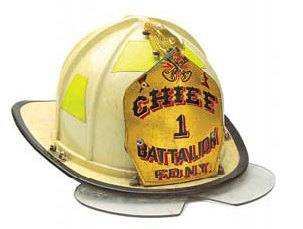
A fire helmet that belonged to Chief Joseph Pfeifer.
Joseph Pfiefer, the battalion chief of Engine 7, Ladder 1, was on a routine call in downtown Manhattan when he heard the roar of American Airlines Flight 11 passing overhead on course to the North Tower of the World Trade Center. His unit was one of the first to arrive at the scene, and he set up a command center in the North Tower's lobby. That day, he was being followed by two French filmmaker-brothers, Jules and Gedeon Naudet, and their footage from the scene shows Pfiefer's brother Kevin, also a firefighter in a different unit, preparing to head upstairs for the unfolding rescue mission. When the South Tower collapsed, Pfiefer radioed evacuation orders to his officers in the North Tower. Pfiefer, along with the rest of Ladder 1, survived that day. His brother did not.
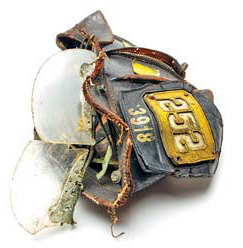
A recovered FDNY Squad 252 helmet that belonged to deceased FDNY member, Kevin M. Prior.
Kevin Prior, a firefighter with Brooklyn's Squad 252, can be seen in video footage of the North Tower lobby recorded after the first plane hit, getting ready to go upstairs. Responding to a Mayday call sent out by fellow firefighters encountering breathing problems, he and five other members of the squad are thought to have been on a floor in the 20s when the tower collapsed. Prior's body was found three weeks after the attacks and buried on Long Island, but his mother was troubled that his helmet had not been returned to the family, and said as much in a television interview. An employee at the city's Office of the Chief Medical Examiner happened to catch the broadcast, recognized Prior's squad and badge numbers, and hand-delivered the badly damaged helmet to his grateful family.
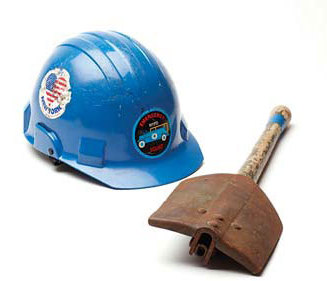
An NYPD Emergency Service Unit hardhat and folding shovel used on Sept 11, 2001 and during the clean-up period at ground zero, by police officer Kenny Winkler of NYPD ESU 1.
Kenneth Winkler was off-duty from a night shift as an officer with the New York Police Department's Emergency Service Unit, on the morning of the attacks. He nonetheless joined his colleagues on their vehicle and they raced toward the World Trade Center, and stayed in the vehicle outside to coordinate communications between different parts of the force. After the South Tower collapsed, he ordered everyone still inside the North Tower to leave. He had to abandon the vehicle after the North Tower collapsed, and set up a new command center nearby and continued to try and coordinate communications. Later, he would work on the pile during the rescue operation, wearing his NYPD hardhat and carrying his hand shovel, and returned periodically to the site during the following nine-month clean-up operation.
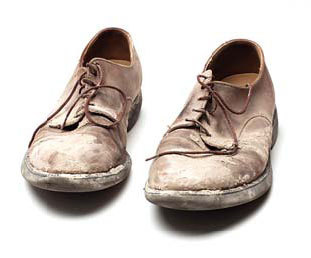
Shoes of survivor Roger Hawke during his evacuation from the 59th floor of the North Tower.
Roger Hawke worked at Sidley Austin, a law firm that had offices on the 57th through 59th floors of the North Tower. This was not the first attack on the World Trade Center he had lived through: He was there in 1993 too, when bombs exploded at the complex. Soon after the first plane crashed somewhere above him on 9/11, he made his way to one of the increasingly crowded and hot stairways. It took about 90 minutes to descend to safety. He headed on foot to the apartment of his daughter and son-in-law on the Upper East Side, arriving there caked in ash, leaving his dust-choked shoes at the door before entering. His 4-year-old granddaughter jumped into his arms but then recoiled at the smell of smoke permeating his clothes: "Papi is on fire from the inside," she said.
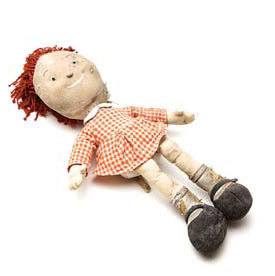
A "Little Red" doll discovered by Brian Van Flandern on Sept 12, 2001.
Brian Van Flandern awoke in Queens on the morning of 9/11 to the news of a plane hitting the North Tower, and was determined to volunteer despite his emergency medical technician license having recently expired. After repeated failed attempts to enroll at several impromptu volunteer coordination centers that had sprung up around the city that day, he decided to head to the World Trade Center site and managed to get past a checkpoint to join other volunteers on what became known as "the pile". He spent 24 hours helping search for trapped and wounded survivors. Morale quickly flagged: He recalls only one successful rescue, in which a man was freed from a piece of steel piercing his ankle. Before leaving the site, he found a rag-doll in the rubble. At first, it seemed to be evidence of a child caught up in the attacks. He later learned it was one of several mascot dolls that sat together on the shelf in the offices of the Chances for Children charity on the 101st floor of the North Tower, other examples of which were found scattered far and wide across Lower Manhattan.
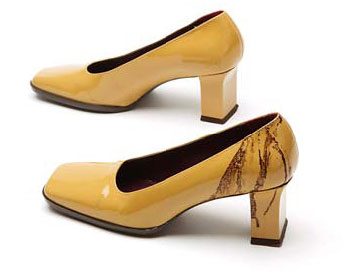
Blood-stained shoes worn by Linda Lopez as she was evacuated from the 97th floor of Tower 2 on Sept 11, 2001.
Linda Lopez was at work at the Fiduciary Trust Company on the South Tower's 97th floor when the first plane crashed into North Tower, sending a fireball past their window and radiating a heat that she said felt like being sunburned. There was quickly a sense of confusion: Was it a bomb? Were the rumors that it was a plane crash true? Should people in the South Tower ignore the advice coming over the public address system to stay put and evacuate instead? Lopez felt she had to get out. She had reached only as far as the 61st when she was thrown against a wall as the second plane crashed into the floors above her. Taking off her shoes, she continued to head down the stairs, passing firefighters heading in the opposite direction. She ran barefoot out of the building, across broken glass and other debris. "Lady, your feet are bleeding," someone said to her as she paused a few blocks away in relative safety. She put her shoes back on, and began learning the details of what it was she had just escaped from.
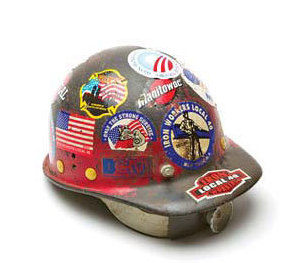
Ironworker construction helmet belonging to Larry Keating.
Larry Keating was an ironworker foreman who helped oversee the removal of wreckage from the World Trade Center site during the nine-month clean-up operation following the attack, and was chosen by the ironworkers union, Local 40, to represent his colleagues at the ceremonial removing of what became known as Last Column - an upright piece of the towers that had become covered in mementos from the clean-up workers and from which flew an American flag. He wore his hardhat throughout the clean up, and continued to wear it proudly for site visits until his death in 2011 from a heart attack.
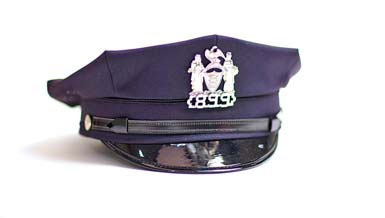
A Port Authority Police Department uniform hat, badge number 899, and Port Authority Pipe Band hat belonging to victim Liam Callahan.
Liam Callahan was a Port Authority police officer who had been commended for his "heroic actions" after responding to the 1993 World Trade Center bomb attack, and was a first responder on the morning of 9/11. Even after the towers collapsed, Joan, his wife, continued to hope he might somehow turn up in time for the celebration of their 20th wedding anniversary the next day. He was killed at the age of 44. His family donated his Port Authority police uniform hat and the uniform he would wear as a drum sergeant in the force's Emerald Society Pipes and Drums band.
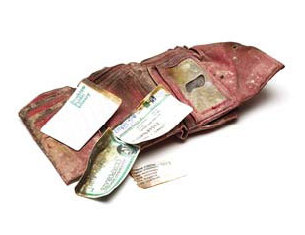
A red wallet belonging to victim Gennie Gambale, recovered from the rooftop of the Marriott Hotel at the World Trade Center.
Gennie Gambale was a vice president at Cantor Fitzgerald and was working on the 103rd floor of the North Tower when the first plane crashed into the lower floors, trapping those above. Her family put up thousands of posters around town in the hopes that she might be found alive, but it was in vain; she was 27 when she was killed. A police officer, who happened to be the mother of one of Gambale's friends, found Gambale's wallet on the roof of the nearby Marriott hotel and immediately recognized the name on the damaged cards inside, and ensured it was quickly handed over to the family.
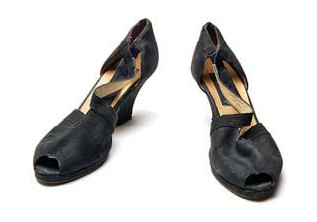
Shoes worn by Florence Jones on Sept 11, 2001 as she escaped from the World Trade Center.
Florence Jones was still in her office at Baseline Financial on the South Tower's 77th floor when the second plane crashed into the building just one floor above. She and several colleagues tried two stairwells before finding their way to stairwell A, the only one not damaged by the crash. She took off her high-heeled shoes to hasten her descent - her boss carried them down for her. They were among the last to make it out of the tower before it collapsed.
Reuters


















